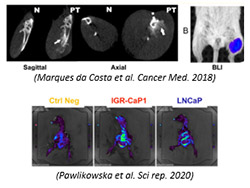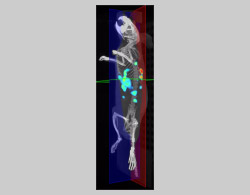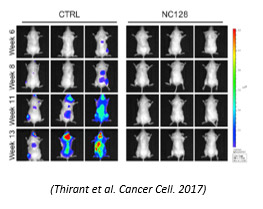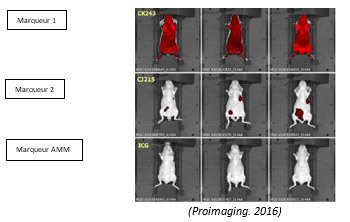Clinical Transfer Imaging - Activities
PFIC has the particularity to develop the transfer of photonic imaging for clinical applications in R&D division. R&D division is focused on the development of photonic tools mainly in collaborations with surgeons and pathologists to support tumor limits control, lymph nodes identification and flap perfusion viability. Our R&D division is engaged in ex vivo and in vivo clinical programs since 2008 with:
- Preclinical study (Abbaci et al 2014 and 2015) followed by clinical bicentric study (PHRC-K MEC-ORL) to evaluate endomicroscopy in head and neck cancer (Abbaci et al, 2021).
- Preclinical study to develop endomicroscopy for peritoneal carcinomatosis diagnosis (BPI France PERSEE) (Abbaci et al 2016)
- European preclinical study to develop and transfer full-field optical coherence tomography for head and neck cancer (European funding CAREIOCA) (De Leeuw et al 2020)
- Preclinical and clinical study for NIR autofluorescence macroscopy for preservation of parathyroid glands in thyroidectomy cancer surgery (ligue contre le cancer)(De leeuw et al 2016, Abbaci et al 2018, Hartl et al, 2019)
- Clinical study for sentinel lymph node identification by ICG NIR fluorescence macroscopy in breast cancer surgery (Mazouni et al, 2018)
- Clinical study for flap perfusion assessment by NIR fluorescence imaging in Head and neck reconstructive surgery (industrial funding)
- Clinical study for axillary reverse mapping by ICG NIR fluorescence breast cancer surgery (PHRC K ARMONIC) (Abbaci et al 2019)
- Clinical study on evaluation of tumor limits after ICG administration in head and neck cancer (PHRC-K MAGNOLIA)
- Preclinical study for assessment of ultra-fast confocal fluorescence microscope for breast cancer specimens imaging (industrial funding)
- Preclinical study for assessment of ultra-fast confocal fluorescence microscope for ex vivo sentinel lymph node real-time diagnostic in head and neck cancer (fondation de l’avenir)
ClinicalTrials.gov Identifier:
Industrial collaborations: Mauna Kea Tech, LLTech, Clerad, SamanTree medical, Kaier Labs, Avelas biosciences
Patent: red and far-red fluorescent dyes for the characterization of biological tissues at a cellular level - fr 27452/024WO1
Small animal imaging
From whole body…
Non-invasive imaging is a major tool and has become essential for evaluation of tumor models. Current strategies based on deep orthotopic grafts require imaging tools for qualitative and quantitative evaluation without side effect on biology. Bioluminescence/fluorescence meets these requirements. Two optical devices are available at the PFIC platform for preclinical research: IVIS50 and IVIS Spectrum.
These instruments allow:
- focused or whole body imaging in real-time for a sensitive and early detection of primary tumors and metastases
- long-term, qualitative and quantitative studies on the same individuals
- combination of biologic information simultaneously collected from multiple bioluminescent/fluorescent probes (max 5 biomarkers simultaneously).
The IVIS Spectrum also offers CT tomography for 3D location of optical sources within the whole body. X-Ray scans can be acquired separately from optical detection for anatomical analysis of bone lesions or soft tissues with high CT contrast.
Main applications of optical imaging conducted at Gustave Roussy are:
- Dynamic characterization of tumor models and alternative preclinical models

- Bioluminescence and fluorescence imaging

- Evaluation of therapeutic strategies (chemotherapy, vaccination, radiotherapy...) and new vectors of molecules

- Evaluation of new fluorescent contrast agents for early and specific detection of tumor lesions after systemic, subcutaneous or topic administration

In collaboration with academic research units or industrial groups, protocols have been developed in other clinical areas (examples: optimization of chemical composition for mucoadhesive gels, evaluation of a calcium channel promoter…)
To cell…
Whole body optical imaging is a powerful and highly sensitive tool adapted to multiple individuals screening. However, macroscopic evaluation needs to be completed/explained by the underlying cellular mechanisms. High resolution in vivo imaging is achieved on isolated organs or through dorsal skinfold chamber both allowing visualization of cells/microenvironment interactions. These techniques associated with a macroscope (AZ100M, Nikon) or a confocal/multiphoton microscope (SP8, Leica) allow to characterize in vivo :
- tissue and vessel architecture and extra/intra hemodynamics
- tumor dynamics and metastatic spreading
- cellular interactions
- evaluation of therapeutic efficacy
Our intravital imaging technologies are also available to the national scientific community thus leading to various protocols:
- micromanipulation by thermal ablation and evaluation of tissue regeneration after injection of vascular progenitors (collab. U1197) ;
- oxidative stress quantification during inflammation (collab. CNRS UMR 7645) ;
- in vivo biodistribution of magnetoliposomes (collab. UMR8612);
- dystrophin expression in macular degeneration (collab. END-ICAP UVSQ).
Closed to the preclinical experimentation platform, all in vivo procedures are conducted by a trained and authorized staff in compliance with european guidelines.
